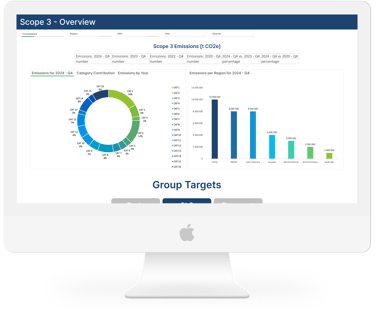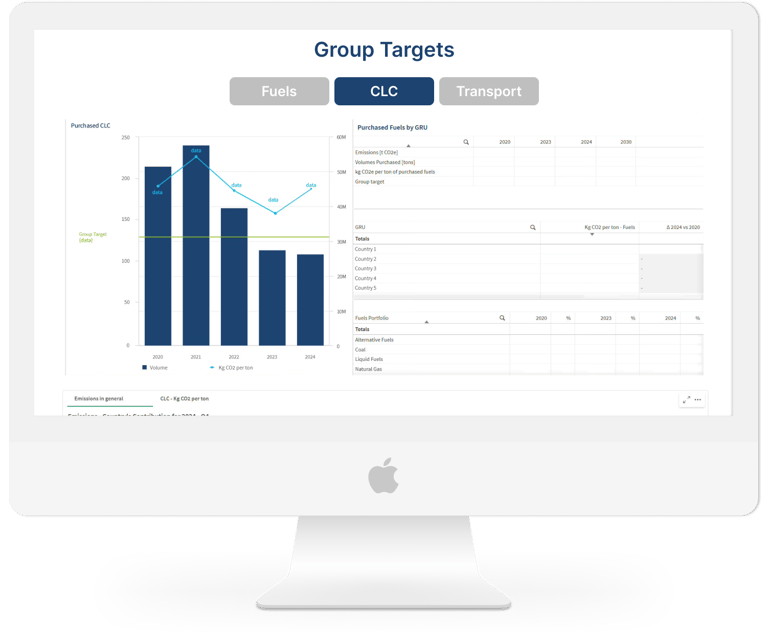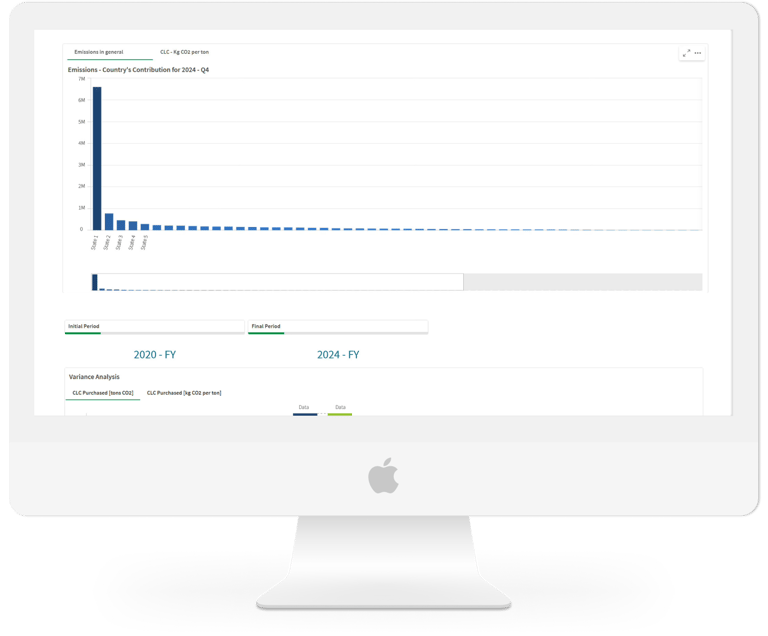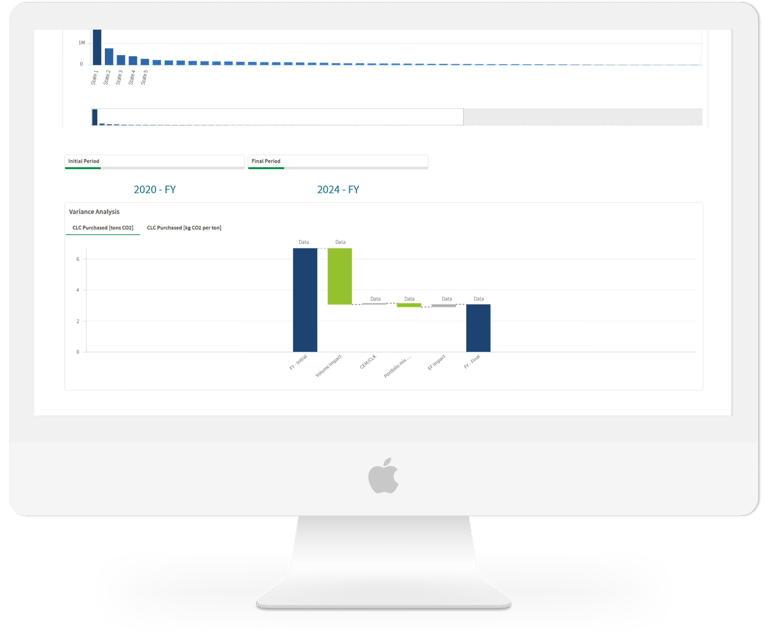Scope 3 Dashboard


Cement Industry
*Due to confidentiality, all data and locations shown here are fictional. The layout and interactions faithfully represent the original solution from QlikSense, rebuilt in Figma and Excel for this portfolio.
Role
Data Visualisation Designer / QlikSense Developer
Tools
Figma . QlikSense . Excel
Year
2024
Scope 3 Dashboard


Cement Industry
*Due to confidentiality, all data and locations shown here are fictional. The layout and interactions faithfully represent the original solution from QlikSense, rebuilt in Figma and Excel for this portfolio.
Role
Data Visualisation Designer / QlikSense Developer
Tools
Figma . QlikSense . Excel
Year
2024
Overview
This project bridges my data engineering background with UX/UI design principles. Scope 3 dashboard focused on emissions data generated during the cement production process. The main objective was to present historical and projected emissions data and highlight progress toward the Paris Agreement targets and SBTi.
The dashboard was designed to help stakeholders track performance, explore trends, and understand how each region, country or category contributes to the global sustainability goals.
1.Research
The cement industry is one of the largest emitters of greenhouse gases globally and the company aimed to align with Science-Based Targets initiative (SBTi) goals.
I started by exploring:
Basic knowledge about emissions, SBTi, key metrics and units
How emissions are categorized under Scope 3 (16 categories total)
What KPIs matter most to sustainability and operations teams (e.g., emissions by region, supplier, and quarter)
Existing dashboards and reports within the company
Dive deep into data and back end/front end coding in QlikSense/SQL to understand ETL process
Key Insights
Stakeholders needed to quickly compare emissions trends across years and regions
Users wanted interactive filtering (by region, country, consolidation level, time period) to view custom summaries
The existing dashboard’s layout made it difficult to see the “big picture”
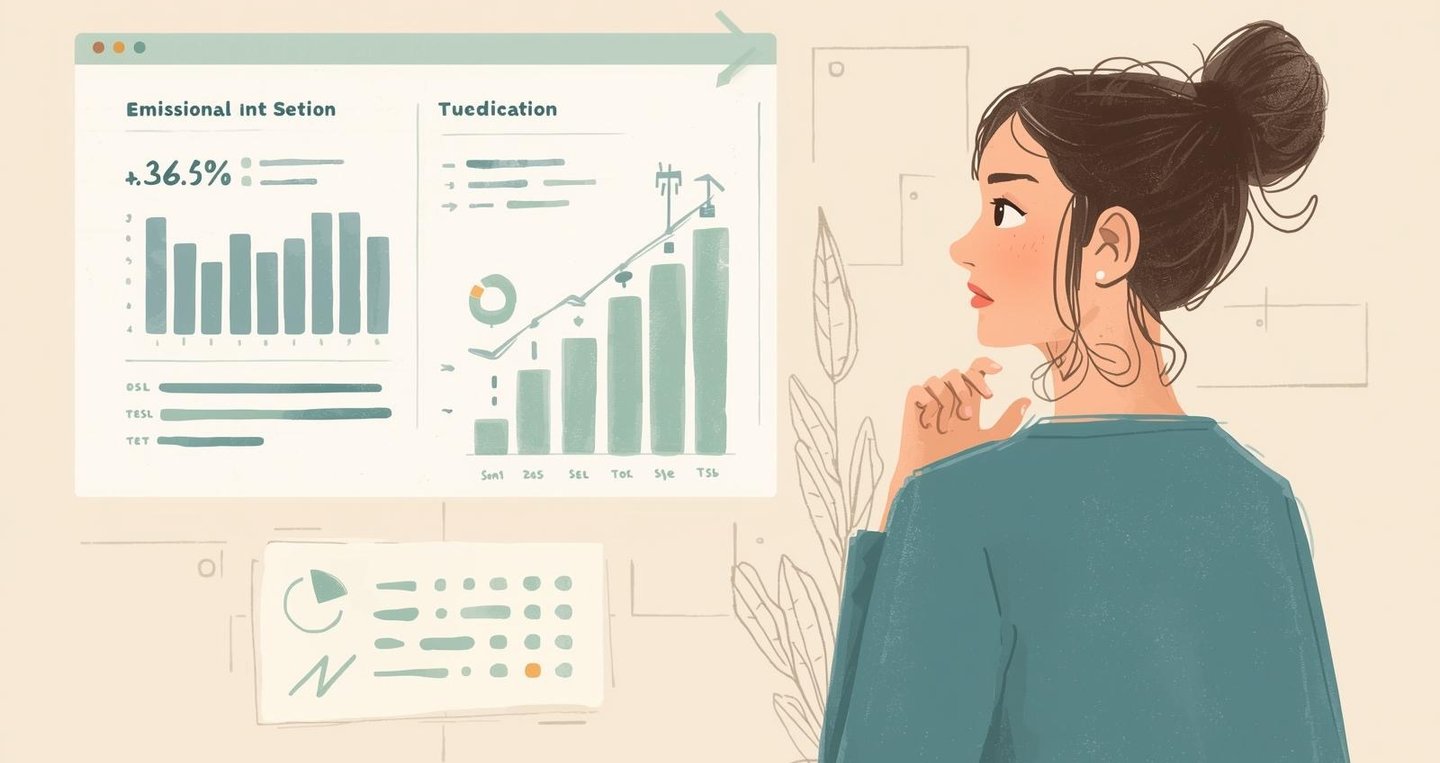

1.Research
The cement industry is one of the largest emitters of greenhouse gases globally and the company aimed to align with Science-Based Targets initiative (SBTi) goals.
I started by exploring:
Basic knowledge about emissions, SBTi, key metrics and units
How emissions are categorized under Scope 3 (16 categories total)
What KPIs matter most to sustainability and operations teams (e.g., emissions by region, supplier, and quarter)
Existing dashboards and reports within the company
Dive deep into data and back end/front end coding in QlikSense/SQL to understand ETL process
Key Insights
Stakeholders needed to quickly compare emissions trends across years and regions
Users wanted interactive filtering (by region, country, consolidation level, time period) to view custom summaries
The existing dashboard’s layout made it difficult to see the “big picture”


2.Define
Problem Statement
“How might we help sustainability managers and stakeholders easily monitor Scope 3 emissions performance and identify which areas contribute most to overall emissions?”
Goals
Simplify and edit data model and back end calculations
Simplify data interpretation for non-technical users
Enable dynamic filtering that updates all visualizations consistently
Present data in a clean, modern, and corporate - color theme interface
Data storytelling with the charts
Success Metrics
Reduced time to find key metrics
Consistent visuals across sheets
User - friendly interactive design
Positive stakeholder feedbacks after internal testing

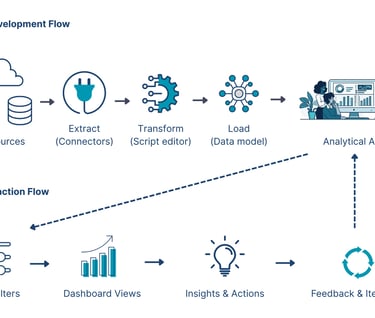
2.Define
Problem Statement
“How might we help sustainability managers and stakeholders easily monitor Scope 3 emissions performance and identify which areas contribute most to overall emissions?”
Goals
Simplify and edit data model and back end calculations
Simplify data interpretation for non-technical users
Enable dynamic filtering that updates all visualizations consistently
Present data in a clean, modern, and corporate - color theme interface
Data storytelling with the charts
Success Metrics
Reduced time to find key metrics
Consistent visuals across sheets
User - friendly interactive design
Positive stakeholder feedbacks after internal testing


3.Ideate
Since the original dashboard layout is not available, I recreated the structure in Figma for internal discussions.
The focus was on what data to display, which chart types best conveyed it, and how to support quick, informed decisions.
Together with stakeholders, we explored different ways to visualize Scope 3 emissions across time, regions, and categories.
Discussions centered mainly around KPIs and chart types, refining how insights were presented.
Color direction evolved through feedback — I began with full creative freedom, but we ultimately aligned with the company’s brand palette: blue, green, and grey, with one accent color for emphasis.
Each iteration brought us closer to a design that balanced data clarity, brand identity, and stakeholder preferences.

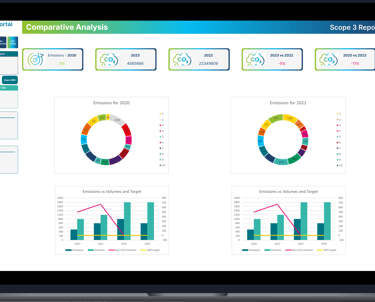
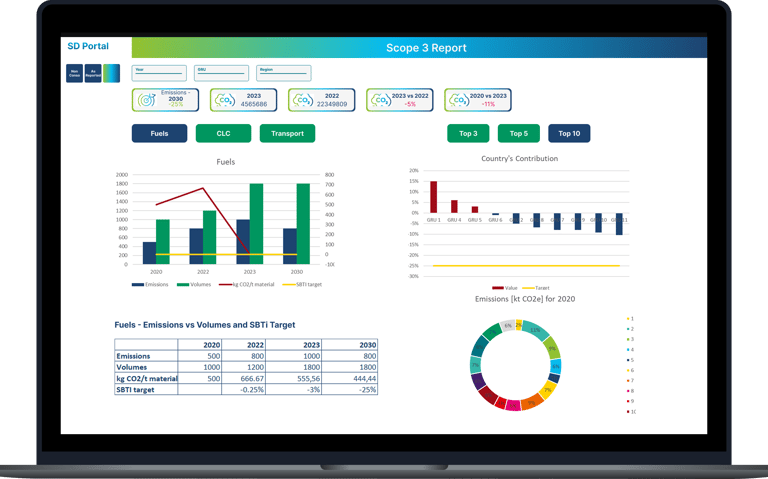

Example of the Comparative Analysis, so a user can compare the results for various categories, countries for the selected year and quarter
Example of the Landing Page for various sections, categories, units for particular years and quarters
3.Ideate
Since the original dashboard layout is not available, I recreated the structure in Figma for internal discussions.
The focus was on what data to display, which chart types best conveyed it, and how to support quick, informed decisions.
Together with stakeholders, we explored different ways to visualize Scope 3 emissions across time, regions, and categories.
Discussions centered mainly around KPIs and chart types, refining how insights were presented.
Color direction evolved through feedback — I began with full creative freedom, but we ultimately aligned with the company’s brand palette: blue, green, and grey, with one accent color for emphasis.
Each iteration brought us closer to a design that balanced data clarity, brand identity, and stakeholder preferences.


Example of the Comparative Analysis, so a user can compare the results for various categories, countries for the selected year and quarter


Example of the Landing Page for various sections, categories, units for particular years and quarters
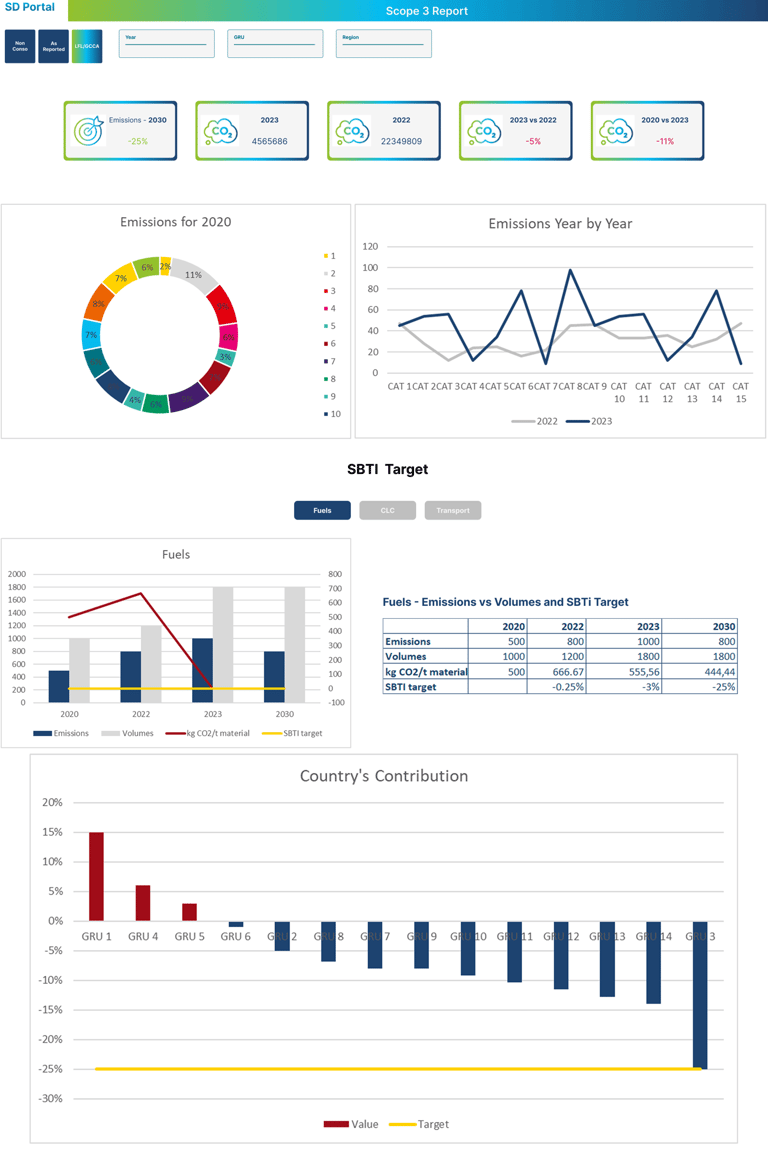

Final Figma version of the Landing Page with a clearer narrative and simplified visuals. Red and blue indicate performance trends; several details were later refined during development.

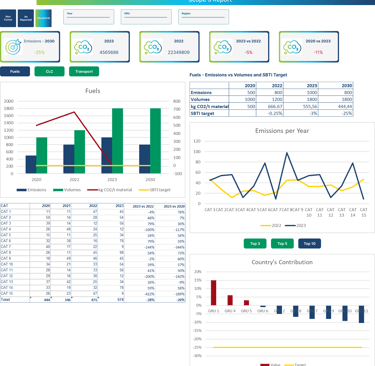
Example of the updated Landing Page after stakeholder's feedback — introducing additional tables and charts, a simplified color palette, and clear use of red and blue to indicate performance.


Final Figma version of the Landing Page with a clearer narrative and simplified visuals. Red and blue indicate performance trends; several details were later refined during development.


Example of the updated Landing Page after stakeholder's feedback — introducing additional tables and charts, a simplified color palette, and clear use of red and blue to indicate performance.
4.Prototype
I developed the final Scope 3 Dashboard prototype in Qlik Sense - consisting of four sheets:
Overview, Category Views, Detailed Report, and Validation Tables.
Only the Overview was designed as a visual landing page, combining KPIs and charts to tell the overall emissions story.
The other sheets provided deeper analytical tables used internally for validation and data traceability.
While most of the user-facing design effort focused on the Overview, I also ensured a smooth experience across the entire app —
managing how filters, bookmarks, and selections behaved between sheets so users could move between high-level summaries and detailed data seamlessly.
4.Prototype
I developed the final Scope 3 Dashboard prototype in Qlik Sense - consisting of four sheets:
Overview, Category Views, Detailed Report, and Validation Tables.
Only the Overview was designed as a visual landing page, combining KPIs and charts to tell the overall emissions story.
The other sheets provided deeper analytical tables used internally for validation and data traceability.
While most of the user-facing design effort focused on the Overview, I also ensured a smooth experience across the entire app —
managing how filters, bookmarks, and selections behaved between sheets so users could move between high-level summaries and detailed data seamlessly.
5.Test
After developing the prototype in Qlik Sense, I ran several feedback sessions with stakeholders.
Each meeting focused on reviewing functionality, visuals, and data accuracy directly in the dashboard.
Key feedback themes:
Logic behind tables and charts
Filter behavior and consistency
Color palette alignment with brand standards
Bugs or incorrect data values
Placement of graphs and tables
Adding or removing visuals, buttons, and charts
These iterative sessions helped refine both the usability and data reliability, ensuring a stable and visually cohesive final version.
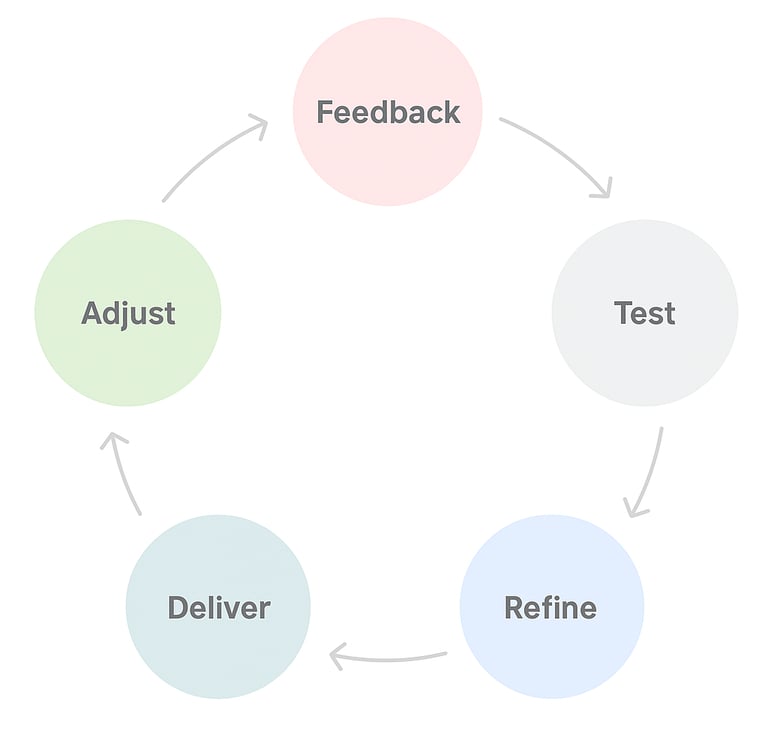

5.Test
After developing the prototype in Qlik Sense, I ran several feedback sessions with stakeholders.
Each meeting focused on reviewing functionality, visuals, and data accuracy directly in the dashboard.
Key feedback themes:
Logic behind tables and charts
Filter behavior and consistency
Color palette alignment with brand standards
Bugs or incorrect data values
Placement of graphs and tables
Adding or removing visuals, buttons, and charts
These iterative sessions helped refine both the usability and data reliability, ensuring a stable and visually cohesive final version.


6.Takeaways & Reflections
This project taught me how to connect design and data logic.
Coming in with limited coding experience, I learned to debug, model, and visualize data — transforming complex emission metrics into clear, human-readable dashboards.
It strengthened my understanding of how every chart choice and color decision affects storytelling and user clarity.
Working with four supportive stakeholders shaped my collaborative approach.
Through open discussions and iterative feedback, we refined chart behavior, visual clarity, and the underlying data logic — ensuring that selections, measures, and visual updates worked seamlessly across all views.
I especially valued the mutual respect and open communication within the team, which created a space where feedback was constructive, learning was shared, and every iteration brought us closer to the right solution.
I see creativity in both design and development. Design is about expression; development is about problem-solving — and I love that spark of joy when something I’ve built finally works. This project helped me see how both sides complement each other. If I revisited it today, I’d focus on clearer storytelling through simpler visuals, stronger contrast, and more readable charts.
6.Takeaways & Reflections
This project taught me how to connect design and data logic.
Coming in with limited coding experience, I learned to debug, model, and visualize data — transforming complex emission metrics into clear, human-readable dashboards.
It strengthened my understanding of how every chart choice and color decision affects storytelling and user clarity.
Working with four supportive stakeholders shaped my collaborative approach.
Through open discussions and iterative feedback, we refined chart behavior, visual clarity, and the underlying data logic — ensuring that selections, measures, and visual updates worked seamlessly across all views.
I especially valued the mutual respect and open communication within the team, which created a space where feedback was constructive, learning was shared, and every iteration brought us closer to the right solution.
I see creativity in both design and development. Design is about expression; development is about problem-solving — and I love that spark of joy when something I’ve built finally works. This project helped me see how both sides complement each other. If I revisited it today, I’d focus on clearer storytelling through simpler visuals, stronger contrast, and more readable charts.

